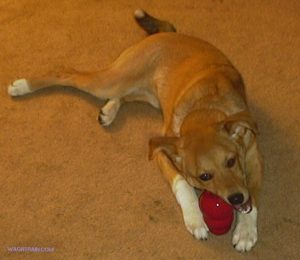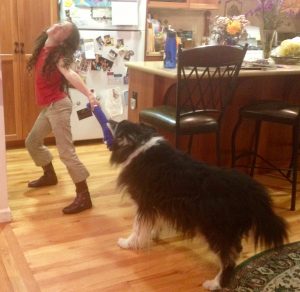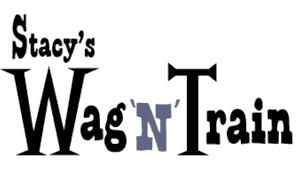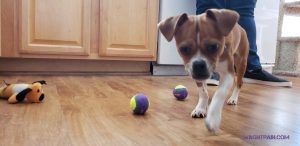Keeping your dog entertained during bad weather (or while in quarantine)
Exercise and mental stimulation when you can’t go outside.
When the weather is stormy or the air quality abysmal (or if we’re asked to quarantine to contain a rampant viral pandemic) we may need to find some creative ways to help our dogs deal! Why is this sort of “environmental enrichment” important?
- It reduces stress for the dog – which will help your stress, too!
- It can help dogs who are too triggered by all the extra people and dogs you encounter when you walk
- It keeps your dog occupied while you’re busy with work or helping your kids
Main categories:
- Food toys – make meal time entertainment time
- Playing – tug, fetch, find, and more
- Learning – basic training and tricks
Food-dispensing toys
While the rest of us might not be enjoying figuring out the tricks of Instacart, many dogs do enjoy food puzzle toys!
Toys you can fill with dry food
These should be easy to open up so you can fill them quickly and clean them out. For example:
- Kong Wobbler
- Kibble Nibble
- Atomic Treat Ball
- Tug-A-Jug
- Paw5 Rock N Bowl
- Snuffle mat (or your lawn)
- Green slow-feeder (dry or wet)
- Nina Ottosson puzzles: Dog Smart, Casino, Tornado, Hide N’ Slide, Maze, or Twister (dry or small amounts of wet)

Toys you stuff with wet/sticky food
- Kongs – use black “extreme” Kongs for stronger dogs
- Busy Buddy Squirrel Dude
- Toppl
- Thundertoy
- LickiMat
Here are a couple of videos in which I show you how I stuff a Kong! (The whole process is here: Kong stuffing video)
Toys which are edible
… or at least partially edible, or in other words, chewies (make sure your dog can’t swallow large chunks or splinters):
- Raw, meaty bones (buy fresh from butcher or super market or wholesale raw food supplier)
- Smoked bones
- Bully sticks (possibly combined with Kong or Qwzl toy)
- Himalayan chews
- Antlers
- Hooves, filled hooves
For even more ideas, see the Ditch the Bowl Training Tip!
Playing
Introduce some new games to your dog – or bring back some old favorites!
Tug

When played with control, this will strengthen the bond with your dog and his obedience to you (never mind those old myths that said this would give your dog ideas about running the world!). Make sure your dog has a decent concept of “drop it” (or “out”), and that he understands that only designated toys are to be used for this – not your hand, not your clothes, socks, shoes, the leash, or your kids! Tug toys should be ideally be long and fairly soft – fleece braids and soft ropes work best.
Fetch
If your dog loves to play fetch but is reluctant to drop the toy, try two-ball fetch. When your dog returns with one ball you’ve thrown, show him a second (ideally, identical) one you’re holding. Wait for the dog to drop the first one, and immediately throw the second one. While he’s fetching that one, you can pick up the first one and be ready to repeat the process. Indoor space only? Try playing with a Hollee Roller toy!
Find it
Hide a food treat or a toy for your dog to find. If this is a new game, have your dog stay (or have someone gently hold the dog, or have the dog tethered) while you demonstrate putting the toy or food treat down very obviously just out of sight – for example, just behind the door frame. Then release the dog to go find it. If he finds a toy, immediately play with it! With food treats, you can hide multiple ones. (Hot tip: I feed my dog his wet food in stuffed, frozen Kong toys, and I hide them first for him to find!)
Keep-away
Most dogs love to play keep-away, and like playing tug, this can actually be used to improve obedience. I start with a very gentle play-threat: I’m gonna get ya! and a short chase (ideally, with the dog holding a toy). Then I’ll ask for a well-known command, like “sit”; if the dog does it I’ll praise and then start again. Once the dog understands that the game is fun (it is often a little scary at first!), and that it will start as soon as a command is followed, I’ll add “come” and “drop it” as some of the more challenging commands!
Wrestling
Some dogs love to be physically wrestled with, although many dogs have to learn that you are actually playing and not threatening them (so do be careful!). Play this the way well-socialized dogs play – with lots of short breaks and check-ins, reading the dog’s body language, and signalling your intentions before you start.
Hide and go seek
This is similar to “find it”, except the item being hidden is you! Start by hiding yourself obviously – let your dog see you go behind the couch or out of the room. Maybe have a toy or treat with you to increase your dog’s motivation to find you. Have the dog on a stay, or someone else gently holding him. Then release the dog and let him seek you out! Make a big fuss over his finding you, maybe give a treat or play with the toy. If you have a second person holding the dog, you can have her cue the dog with “Go find Mom!” or whatever you want to use. Gradually make your hiding spots a little harder!
Learning
If you’ve got downtime – or just need a break from your other demands – teaching your dog something new can be fun for both of you! Use some sort of marker (a clicker or the word yes!) to clearly highlight the moment your dog reaches your current goal, and some sort of positive reinforcement or reward – which could be food, a toy, an activity, or a choice.

Practical
Practical training is teaching your dog good manners. This could things like:
- Sit to have the leash put on
- Go lie down and stay while the kids do homeschool
- Wait for the food or water dish to be put down
- Go in a crate or pen on cue
- Leave it with an item dropped on the floor
Husbandry Training
Husbandry Training is teaching an animal to be cooperative in her own healthcare or grooming. You can teach a dog to be calmer and endure
- Hair-brushing
- Nail clipping
- Hair trimming
- Being held still during an examination (such as a vet might do)
- Having teeth brushed
- Receiving a shot
- Having feet wiped
Here’s a tip: start with the smallest level of challenge. If your dog hates having his feet handled for nail trimming, start by having him sit while you touch his shoulder, then lower on his foreleg, then lower still, then touching the foot. Then you can increase the duration of the foot touch, or start gently grasping it. If you do many “reps”, and follow each each success with a high-value food treat, you can make a lot of progress pretty quickly – just don’t expect to go from screaming to calm acceptance in just one session. Hey, we might be here for a while – take your time!
Fun tricks
Some ideas include:
- Jumping through a hula hoop or over a broomstick. Start with the item touching the ground, then gradually raise it with a number of successful, rewarded repetitions. Hot tip – deliver the treat to the ground near where you expect the feet to land, not up high.
- Spin
- Take a bow
- Jump into your arms
- Go around a chair
- Hold an object (great for posing for pictures!)
Did you notice that some of these ideas can be combined? You can use playing tug as a reward for coming when called, or hide yourself with your dog’s food puzzle toy to find. Mix it up, be creative!
Back to Stacy’s Training Tips
All material copyright Stacy Braslau-Schneck.
Would you, your training company, or your club like to reprint this? Please be sure to keep my name, business name, and the website URL with the article, and if possible, please send me a copy. See the Contact Page for email and mailing address.
Note: As an Amazon Associate I earn from qualifying purchases.


